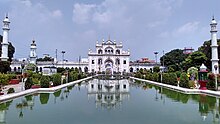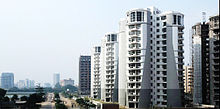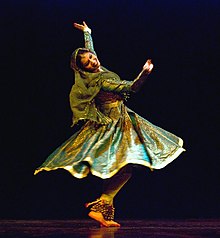Lucknow
Lucknow (/ˈlʌknaʊ/; Hindustani: [ˈləkʰ.nəuː] ⓘ Lakhanaū) is the capital and the largest city of the Indian state of Uttar Pradesh and it is the administrative headquarters of the eponymous district and division.[9] It continues to be an important centre of governance, administration, education, commerce, aerospace, finance, pharmaceuticals, information technology, design, culture, tourism, music, and poetry.[25] He became a puppet king, and in a treaty of 1801, yielded large part of Awadh to the East India Company while also agreeing to disband his own troops in favour of a hugely expensive, British-controlled army.The treaty of 1801 proved a beneficial arrangement for the East India Company as they gained access to Awadh's vast treasuries, repeatedly digging into them for loans at reduced rates.[28] It is the most important center of Shia Islam in the Indian Subcontinent and has influence of Persian, Shiite, Arabic and British culture and tradition in the architecture, language and customs.[37] Bounded on the east by Barabanki, on the west by Unnao, on the south by Raebareli and in the north by Sitapur and Hardoi, Lucknow sits on the northwestern shore of the Gomti River.[53] The major industries in the Lucknow urban agglomeration include aeronautics, automotive, machine tools, distillery chemicals, furniture and Chikan embroidery.[101] The district police observes the citizenry through high-technology control rooms and all important streets and intersections are under surveillance with the help of CCTVs and drone cameras.In fact 6 high courts (Shimla, Delhi, Jaipur, Chandigarh, Nainital, Jammu) from other states are closer than Allahabad from western Uttar Pradesh.[132] Terminals for city buses are located in Gudamba, Viraj Khand, Alambagh, Scooter India, Institute of Engineering and Technology, Babu Banarasi Das University, Safedabad, Pasi qila, Charbagh, Andhe Ki Chowki, Jankipuram, Gomti Nagar Railway Station, Budheshwar Intersection, Faizabad Road and Qaiserbagh.The cities outside Uttar Pradesh that are covered by inter-state bus services are Jaipur, New Delhi, Kota, Singrauli, Faridabad, Gurgaon, Dausa, Ajmer, Dehradun, and Haridwar.[163] Among the extant architecture, there are religious buildings such as Imambaras, mosques, and other Islamic shrines as well as secular structures such as enclosed gardens, baradaris, and palace complexes.The University of Lucknow shows a huge inspiration from the European style while Indo-Saracenic Revival architecture is prominently present in the Uttar Pradesh Vidhan Sabha building and Charbagh Railway station.It has a multi-level parking lot in place of an old and dilapidated police station making way for extending the corridors into pebbled pathways, adorned with piazzas, green areas and wrought-iron and cast-iron lamp-posts, reminiscent of the Victorian era, flank both sides of the street.[176] It also represents the melting pot of globalisation where the legacy of Nawab's culture continues to be reflected in the traditional vocabulary of the Hindi language of the city along with better avenues for modernisation present here.[181][182] Two poets, Mir Babar Ali Anis and Mirza Dabeer, became legendary exponents of a unique genre of Muslim elegiacal poetry called marsiya centred on Imam Husain's supreme sacrifice in the Battle of Karbala, which is commemorated during the annual observance of Muharram.[183] The revolutionary Ram Prasad Bismil, who was hanged by the British at Gorakhpur jail, was largely influenced by the culture of Lucknow and remembered its name in his poetry.[184] Surrounding towns such as Kakori, Daryabad, Fatehpur, Barabanki, Rudauli, and Malihabad produced many eminent Urdu poets and litterateurs including Mohsin Kakorvi, Majaz, Khumar Barabankvi and Josh Malihabadi.[186] Tunde ke kabab restaurants are popular for a type of soft kebab developed by a one-armed chef (hence the name Tunday) for a Nawab who had lost his teeth.Indian festivals such as Christmas, Diwali, Durga Puja, Eid, Holi, Raksha Bandhan and Vijayadashami are celebrated with great pomp and show in the city.[192] Deva Mela is celebrated during the anniversary of Sufi saint Haji Waris Ali Shah at Dewa, India which is 26 K.M from Lucknow city.This last mourning procession takes place on the morning of the 8th of Rabi' al-awwal, the third Muslim month and includes alam (flags), Zari and a ta'zieh (an imitation of the mausoleums in Karbala).It originates at the Imambara Nazim Saheb in Victoria Street then moves in complete silence through Patanala until it terminates at the Karbala Kazmain, where the colossal black ta'zieh is buried.[202] Lucknow is also the birthplace of musicians including Naushad, Talat Mahmood, Anup Jalota and Baba Sehgal as well as British pop celebrity Sir Cliff Richard.[221][222] Several movies have used Lucknow as their backdrop including Shashi Kapoor's Junoon, Muzaffar Ali's Umrao Jaan and Gaman, Satyajit Ray's Shatranj ke khiladi.[223][224][225] In the movie Gadar: Ek Prem Katha Lucknow was used to depict Pakistan,[226] with locations including Lal Pul, the Taj Hotel and the Rumi Darwaza used in Tanu Weds Manu.[230] A major section of the Bollywood movie, Daawat-e-Ishq starring Aditya Roy Kapur and Parineeti Chopra was shot in the city[231] as was Baawre, an Indian TV drama, airing on the Life OK channel.[234] The country's first prime minister Jawaharlal Nehru founded The National Herald in the city prior to World War II with Manikonda Chalapathi Rau as its editor.Lucknow sports hostel has produced international-level cricketers Mohammad Kaif, Piyush Chawla, Suresh Raina, Gyanendra Pandey, Praveen Kumar and R. P. Singh.Other notable sports personalities include hockey Olympians K. D. Singh, Jaman Lal Sharma, Mohammed Shahid and Ghaus Mohammad, the tennis player who became the first Indian to reach the quarter finals at Wimbledon.













Skyline of Lucknow as seen from Gomti Nagar








Lucknow (disambiguation)MetropolisGomti NagarJaneshwar Mishra ParkBara ImambaraLa Martinière CollegeCharbagh Railway StationAmbedkar Memorial ParkEkana Cricket StadiumHazratganj MarketVidhan BhavanLakshmanaUttar PradeshCountryDivisionLucknowDistrictNamed forMunicipal CorporationLucknow Municipal CorporationMunicipal Commissioner5th in India11th in IndiaDemonymsLanguageAwadhiTime zonePincode(s)+91-522Vehicle registrationGDP NominalPercapitaLucknow DistrictSex ratioInternational Cricket StadiumBRSABV Ekana Cricket StadiumTwin CitySister CityKanpurRapid TransitLucknow MetroInternational AirportChaudhary Charan Singh International AirportIndic textquestion marks or boxescapitalIndian stateeleventh most populous citythe twelfth-most populous urban agglomerationmulticulturalNawabsVaranasiUttar Pradesh Heritage ArcGovernment of Uttar PradeshanglicisedRamayanaSanskritLakshmiKosalaOudh StateSharqi SultanateMughal EmpireNawabs of AwadhEast India CompanyBritish RajHumayunJahangirNawabs of Lucknowcultural capitalChota ImambaraRumi DarwazaGanga-Jamuni TehzeebW. DaniellShia MuslimHussainiyamausoleumMuhammad Ali ShahSaadat KhanFaizabaddisintegratedShuja-ud-DaulaNawab of BengalMir QasimBattle of BuxarAsaf-ud-DaulaMaratha EmpireWazir Ali KhanSaadat Ali Khanpuppet kingResidencyHindi-UrduHenry LawrenceWajid Ali ShahCalcuttaIndian Rebellion of 1857Birjis QadraBegum Hazrat MahalIndia's independence movementgarrisonSiege of LucknowHenry HavelockJames OutramColin CampbellUnited Provinces of Agra and OudhKhilafat MovementprovincialAllahabadIndian independenceMahatma GandhiMohd Ali JinnahIndian National CongressLucknow pactAnnie BesantAmbica Charan MajumdarCongressKakori conspiracyRam Prasad BismilAshfaq Ullah KhanRajendra Nath LahiriRoshan SinghUmrao Jaan15 August 1947Cis-Gomti areaGomti RiverIndus-Gangetic PlainMalihabad












